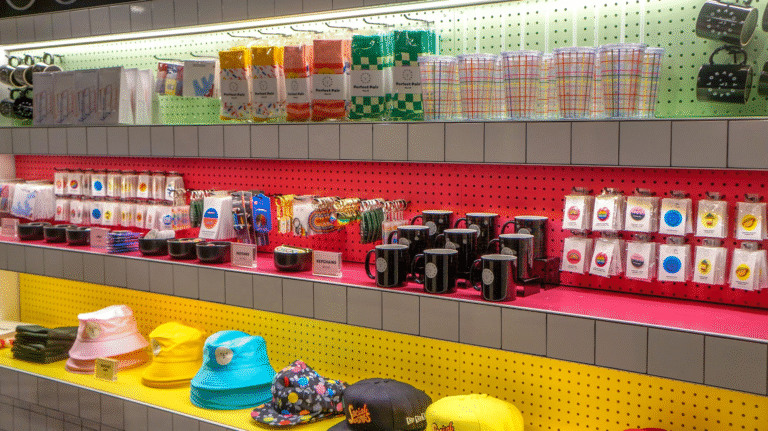Most professional advice on how to promote a clothing brand comes down to two things: branding and marketing. But what is the difference between branding vs marketing? How do people use both in their promotion tactics? Today, let’s look at the basic difference between branding vs marketing and why both matter to you.
Branding vs Marketing
What is branding?
What’s the difference between the local coffee shop you’d find on your street corner and a Starbucks? Or a pair of Nike sneakers and a generic sneaker set that looks exactly the same? That difference lies in branding.
Branding is essentially the storytelling and identity associated with a company. Great branding sells emotions and concepts rather than just products. It’s a bit of a nebulous concept because every company has a ‘brand’ idea whether it’s positive or not. Ideally, a great brand image would lead to the company being associated with strong positive qualities, like class, elegance, strength, wisdom, or other feel-good adjectives.
Branding has become essential over time, especially with the rise of personalization through social media. Over 81% of young customers need to trust a brand before they can consider buying their products, and many also admit that they’re willing to pay more for a brand that they’re loyal to. Strong branding leads to good rep, and good rep leads to more profits over time.
- Branding strategies

We’ve talked a bit about branding in the past, but all strategies around branding come down to building values that match your audience and showing them off. Some specific steps to branding include:
- Showcasing your brand origin story
How did your brand begin? What motivated you or your founders to create the brand? Many companies use their brand origin story to appeal to new audiences. Learning how a company started from humble origins before rising to the top appeals to the human urge to see the ‘underdogs’ succeed.
Similarly, buying from that same company often gives customers a feeling of being a part of the brand story as a whole.
- Capturing a target audience’s voice
As an apparel brand, you have to be dead-set in appealing to a specific niche. Whether it’s streetwear enthusiasts, tech pros or menswear stylists, your brand has to be able to get their attention. And what better way to do that than to capture the voice of their peak ideal?
This is where creating a brand voice comes from. Everything from visuals to advertisements or copywriting comes down to how well they can emulate the brand’s ideal voice.
- Using evocative visuals
Visuals are the first thing people will see of your products, and how you present them shapes your brand’s public identity. Using particular colors, fonts, and others can help shape this completely. For more ideas on how to maximize visuals, check out our guide on emotional branding and its many benefits!
What is marketing?
If branding is the story, marketing is the words being used to tell it. Marketing encapsulates all the activities your apparel brand may do to promote your latest products or lines. This includes advertisements, campaigns, sales discounts, influencer collaborations, and other deals. It’s the other side of branding vs marketing that makes things work.
Unlike branding, marketing is more concrete and consists of executable actions to spread awareness. While branding takes time to complete rather lofty ideas, marketing tends to have more measurable criteria. For example, in digital marketing, what is the conversion rate of a particular copy? How many of your customers are aware of your brand? How likely are they to buy your apparel?
- Marketing strategies

There are two types of marketing strategies nowadays: traditional and digital marketing. The main difference between the two is the setting and location. Traditional marketing uses physical media to spread brand awareness and promotion. Meanwhile, digital marketing uses platforms on the web.
Traditional marketing includes (though it’s far from limited to)::
- Billboards and other physical adverts
- Brochures and other printed marketing pamphlets
- Salespeople promoting a product
- Event marketing (i.e. pop-out stores)
Digital marketing includes:
- Social media accounts and campaigns
- Email marketing campaigns
- Affiliate or influencer marketing campaigns (this can also be traditional marketing, depending on how you execute the influencer campaign)
- Search engine marketing (i.e. optimizing your blog or post queries to appeal to customers searching for specific things)
- How to use both
As you may have picked up, rather than being branding vs marketing, branding and marketing work hand in hand. Great branding means very little when you have no way to spread your brand around. Meanwhile, good marketing feels aimless and sometimes even counterintuitive without clear branding.
Take the common issues with luxury or premium branding, for example. Running a premium or luxury apparel brand limits your marketing options, as common tactics–such as sales or discounts–have the unintended effect of ‘cheapening’ your brand image. Luxury and premium brands run off exclusivity, so spreading awareness without accounting for what audience you want to aim for specifically can do more harm than good.
When you’re bringing together your branding and marketing strategies, consider these steps:
- Always consider what type of audience you’re working with. Where do they normally look for apparel (social media, physical media, stores, etc.)? What styles do they aspire to have? What are their pain points, and how can your apparel solve them?
- Lay out your options and choose marketing strategies that are needed to grow your brand.
If you’re starting out as an apparel brand, awareness is the most important thing to seek out while also paying attention to your budget. In this case, influencer collaborations, digital advertisements, or physical events like pop-up shops should be something to consider.
If you’re a more established apparel brand, however, establishing and reinforcing your brand becomes more important. Using flashier advertisements or temporary events may be a more worthwhile endeavor here. - Plan out your marketing campaign to reflect your brand. If your audience consists mostly of young people, you want your campaign to be punchy, active, and consistently online–so constant social media posting, with varying flavors of copy and content depending on your aims. Different audiences will call for different branding, and therefore different marketing campaigns.
Now that you know the difference between branding vs marketing, what plans will you accomplish for your own apparel brand? Once you’ve built a great marketing campaign, you’ll have the responsibility to distribute and create enough apparel to meet your demand.
Shirtual’s one-stop solution covers road mapping, production, and worldwide distribution for all your international shipping needs. Focus on your branding and marketing–let us handle the rest.






